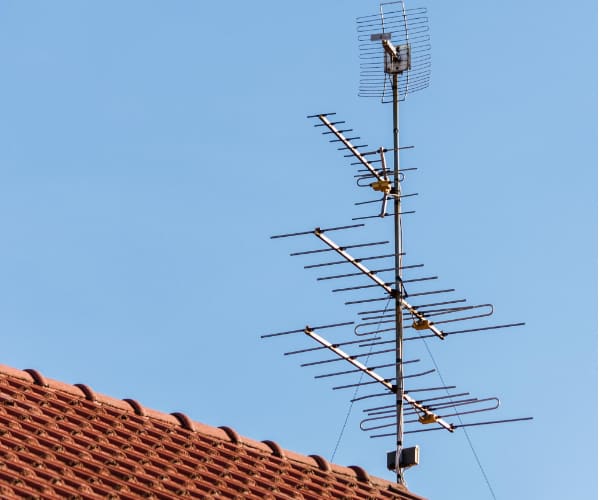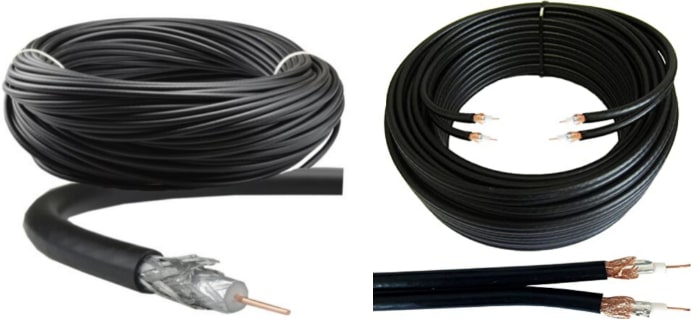Does TV aerial cable quality matter? Yes, of course, it does matter! If you don’t use a good quality TV aerial cable, you won’t get your desired effect from it.
You might receive a weak signal, or the cable might stop working utterly sooner than you expect if you don’t use a good-quality TV aerial cable.
Let’s say that you’re going to install your TV aerial dish by yourself. You need to consider using a long enough aerial cable between your cable TV, like a 10-foot cable or a 50-foot cable, and your indoor antenna.
If you need to do something like link your outbuilding, you’d still need a long cable because your TV will be quite a distance away, and you’d need a reliable antenna cable.
Read along the rest of this article to find out about how you need to use a TV aerial or common coaxial cable lines and how to run this cable.
TV Signal Strengths

First, you need to understand the recommended maximum and minimum signal strengths before you can understand the rest of this article.
For satellite TV, the minimum is 47dB, and the maximum is 80dB. The maximum of analog TV is 80dB, and the minimum is 60dB. DAB radio needs a maximum of 70dB and a minimum of 40dB.
And for FM radio, the maximum is 75dB, and the minimum is 60dB. Last but not least, a TV aerial needs a maximum of 80dB and a minimum of 45dB.
You can use an attenuator if the air antenna signal that enters your cable television is too strong. But don’t exceed these maximum measures if you can.
TV Aerial Cable Losses
Depending on the length of your aerial cable, you might lose the broadcast signal. More length means less strong signal.
For example, there’s a vast difference between a WF65 cable and other larger-sized electrical cables. The WF65 cable is used for installing Sky satellite dishes or different satellite PVRs needing two inputs of coaxial cable. The center conductor of this power cable is 0.65mm.
On the other hand, the WF165 cable with a 1.65mm center conductor has a much more noticeable difference from other cables for satellite internet signals.
Frequency and Cable Losses
The more a frequency signal rises on a coaxial cable for TV antenna, the more signal it loses.
For example, a connection like a satellite LNB that performs between 950Mhz to 2150Mhz loses more signal with distance than an aerial signal that performs between 473Mhz to 698Mhz. But, if you send FM Radio or DAB signals, which have lower frequencies, the same effect is greater.
Communal TV Systems and Cable Length
Among different communal TV systems, MATV and IRS TV systems are the most common type of systems.
The MATV systems usually have different drop-in cables for every apartment and a trunk cable that continues onto tap-off units. And the IRS systems have five trunk coax cables.
In both cases, the signal possibly travels along an extended length of cable for video before entering each apartment. So, the trunk cables reduce cable losses. And you can use an amplifier for both systems.
Signal Sloping
For long feet of cable for HDTV runs and larger TV systems, the signal loss difference over coaxial cable length is very problematic as you need to think about the frequencies for signal losses.
IRS systems are combined on the same cable together for larger communal. This can make the higher frequencies weaker than, the lower ones. Signal sloping is what this is called.
How do you overcome this?
Introduce signals that will carry different signals to lower frequencies at higher levels by utilizing a pre-amplifier, attenuate lower frequencies down, or install slope-adjusting equipment to overcome signal sloping.
Amplification for Overcoming Signal Losses
If you lose signal because of spitters or cable-resistant longer cables, use amplifiers. Let me explain what you need to do in this situation.
Installing an Amplifier
You need to install your amplifier before your signal gets weak in a place where your signal is still strong enough.
For aerial systems, use a masthead amplifier and install it near your outdoor antenna. Don’t wait till your signal is too low to install your amplifier, or it won’t work.
Avoiding Overloading Equipment
Aerial equipment has a maximum capacity for signal strengths and can’t handle more than that. Otherwise, your equipment will overload, causing poor reception, pixelation, damaged equipment, and signal loss.
Use a professional launch amplifier for amplifying signals to a very high level for communal systems.
Satellite Line Amplifiers
You can install satellite line amplifiers to overcome signal losses. They can remove sloping with sloped signal gains, and they are also run by satellite receivers.
The only problem with these is that the signal can become too weak or too strong depending on where you install them. So install these amplifiers mid-way of your cable length.
How to Calculate Aerial Cables Losses
It’s very easy to measure aerial cable losses using the dBµV scale. You only take your desired frequencies
You should consider calculating the signal losses at your highest frequency so that you can unravel how much of the signal loses along the cable length.
Use the same method to measure the mid-range frequency and the lowest frequency for identifying potential signal imbalances or sloping in your TV system.
To do this, you should follow the steps below:
- Find the highest frequency that you’ll be carrying through your aerial cable.
- Recognize the cable length that is required.
- Discover the attenuation of your signal per meter on your chosen cable. The standard is a 1mm coax cable.
- Multiple meter distance by your signal attenuation that you identified earlier.
- Repeat the same process for larger conductor aerial cables if your signal loss is too much.
Maximum Aerial of Coaxial Cable Length
There are a lot of factors affecting how far your air TV signal can travel down a coax cable. So, deciding the maximum coaxial cable length is a very hard thing to do.
You need to know the size of your center conductor, the included amplifications, the signal quality of your cable, and the frequency sent down the cable before you decide on the maximum coaxial cable length.
Tips for Overcoming Cable Losses

I’ll share some tips that you can use to overcome cable losses on a longer cable.
- You should use a high-quality cable to start with.
- Install amplifiers when and where you need them. Remember to install them correctly.
- Use a center conductor cable that is thicker in diameter.
- If the cable length is too long, use fiber optics instead of aerial or coaxial cables.
Final Words
Does TV aerial cable quality matter? Not only does the quality of a TV aerial cable matter, but also the length of the cable. So, remember, the quality of cable matters.
If the length of your cable is very long, you’ll face loss of signal or receive weaker video signals. And, if the frequency of the signal is high, you’ll receive a weak signal or face signal losses.
Hopefully, by now, you know what to do if you’re ever in this kind of situation.
